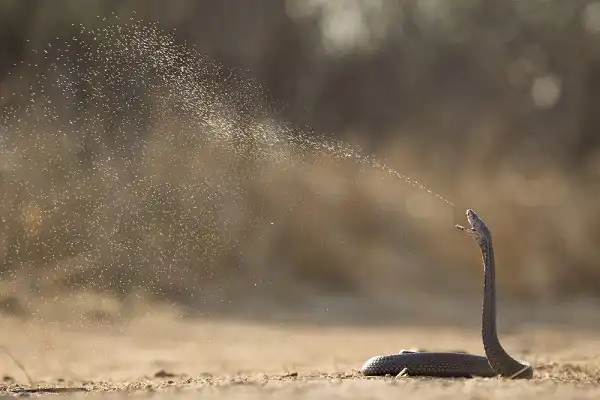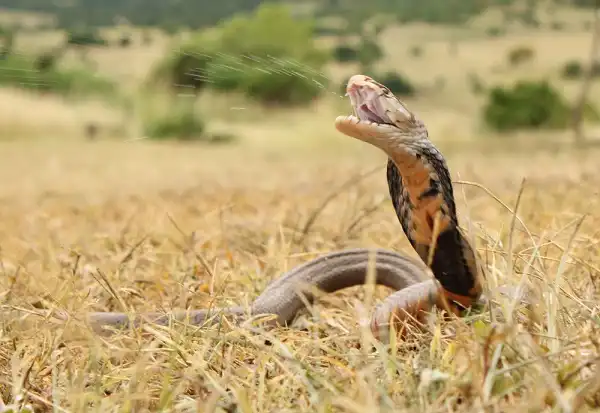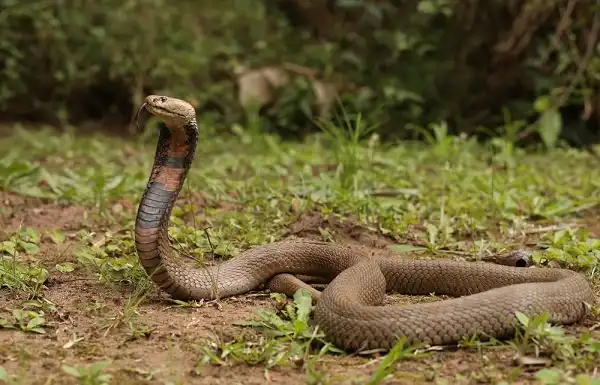If you’ve ever seen a spitting cobra, you know the power and awe-inspiring beauty of these creatures. These venomous serpents have been feared by humans since ancient times due to their incredible hunting skills. Not only are they infamous for their deadly poison, but spitting cobras also possess remarkable adaptations that make them excellent survivors in many different ecosystems around the world. In this blog post, we’ll take an in-depth look at everything you need to know about spitting cobras—from unique traits and behaviors to conservation efforts being made on behalf of these endangered animals.

Spitting Cobra Description
Spitting cobras, also known as spitting or hooded cobras, belong to the Naja genus of venomous snakes found in Africa and parts of Asia. These serpents are generally brown or olive in color, with a distinctive “hood” of overlapping scales that they spread out when they feel threatened. Spitting cobras have evolved remarkable adaptations that allow them to survive in different environments. For example, their long fangs help them penetrate the shells of their prey such as birds and small rodents. Additionally, their spitting behavior is an effective way for them to deter potential predators from attacking them. When threatened, these snakes will hiss loudly and raise the front third of their body off the ground while spreading out their hoods—a warning sign that they are prepared to defend themselves by spraying venom.
Spitting Cobra Habitat
Spitting cobras inhabit tropical and subtropical regions of Asia, Africa, and the Middle East. They are usually found in areas with plenty of vegetation, such as forests, grasslands, and scrubland. These areas provide the cobras with ample sources of food and cover to protect them from potential predators. They can also be found in agricultural fields and near human settlements. Spitting cobras prefer to stay close to water sources, such as rivers or wetlands, where they can hunt small fish or amphibians. They are also excellent climbers that can scale trees, rocks, and walls to escape danger or access their prey. Their habitat varies depending on the species; some live in desert scrubland while others may prefer wetter habitats like rainforests or wetlands. Spitting cobras also have specialized adaptations that help them survive in these different environments; some species have a thickened scale beneath their eyes which helps protect them from dust particles in arid climates while other species have slim bodies which make it easier for them to navigate tight spaces like crevices in rocks or trees.
Spitting Cobra Diet
Spitting cobras are carnivores, feeding mainly on small mammals such as mice, squirrels, lizards, and other reptiles. They also consume amphibians like frogs, toads, and salamanders. They can hunt their prey by sensing vibrations through the ground or in the air with their sensitive hearing organs. When conditions are too dry for hunting small mammals, these snakes can survive by eating insects such as beetles, moths, and grasshoppers. Additionally, when prey is scarce or non-existent spitting cobras will sometimes feed on carrion (the flesh of dead animals).

Spitting Cobra Size
Spitting cobras vary in size depending on the species, but generally range from 1.2 to 3 meters (4 to 10 feet) in length. The Indian cobra (Naja naja) is one of the largest species, growing up to 4 meters (13 feet) long. They have a slender build and are usually brown or black in color. Some species can display patterned markings as well. The head of spitting cobras is relatively large compared to their bodies, and they may have hoods like other cobra species. Their eyes are small and beady, allowing them to sense movement in low light conditions such as nighttime or when burrowing underground.
Spitting Cobra Lifespan
Spitting cobras can live up to 20 years in the wild, although some species have been recorded to live as long as 25 years. These snakes are highly adaptable and can thrive in a variety of habitats from woodlands, and coastal areas to deserts. Although these reptiles are not particularly active during the day, they become more active at night when temperatures are cooler and there is less competition for food. During this time, they may hunt or travel up to several kilometers in search of prey or a new home. Spitting cobras typically mate during the summer months with males competing fiercely for mates. Females lay eggs two months later in late summer or early fall, which will hatch after around two months if incubated—otherwise, it may take longer depending on environmental conditions. The average litter size is between 10-20 eggs, which will grow over one year before reaching adulthood. Young spitting cobras typically disperse quickly after hatching and find their territories with no parental guidance.
Spitting Cobra Behavior
Spitting cobras are solitary animals, usually occupying a particular territory and rarely straying far from it. They are generally more active during the night when temperatures drop and they can hunt more easily, although they may also be seen out during the day in cooler months. Spitting cobras have keen senses of hearing, smell, and vision which help them detect prey or predators nearby. When threatened, these snakes will display aggressive behavior such as inflating their hoods and hissing loudly to appear larger and more intimidating. If this does not work, they may also lash out with their venomous spit or bite if attacked. These serpents are also known to mark their territories using scent glands located near their tails. This helps them recognize each other and fend off potential competitors from the same species. In addition, spitting cobras are capable of recognizing individual scents of other species such as humans or other predators through chemical communication.

Spitting Cobra Speed
Spitting cobras are known for their speed and agility, able to move quickly and strike with incredible accuracy. These snakes are capable of running up to 10 mph, making them one of the fastest land predators in the world. Another remarkable feature of spitting cobras is their ability to spit their venom up to 10 feet (3 meters). This venom is composed of proteins, enzymes, and other toxins which can cause painful burning sensations and even death if ingested by humans. Spitting cobras have adapted specialized muscles that help them launch these venom-filled projectiles at speeds of up to 50 mph! To maintain such high speeds over long distances, spitting cobras have evolved efficient cardiovascular and respiratory systems which allow oxygenated blood to be constantly supplied throughout the body. This helps the snakes stay agile during intense movements or when engaged in battle – giving them a distinct advantage over many would-be predators.
Spitting Cobra Hunting
Spitting cobras are excellent hunters, utilizing a combination of stealth, speed, and accuracy to surprise and capture their prey. They use their keen sense of smell to detect the presence of potential food items from afar. When they come within striking distance, they take advantage of their fast reflexes and agility by quickly aiming with their venom-filled fangs. In addition to being able to identify prey visually, these snakes have a special ability called chemoreception which helps them locate meals through chemical cues in the air or on the ground. This is extremely useful for finding prey that cannot be seen with the naked eye such as small mammals, reptiles, amphibians, insects, and birds. Spitting cobras will also often employ ambush tactics when hunting. They will wait patiently in hiding until an unsuspecting victim passes nearby before springing into action with lightning speed. If successful, they will deliver a venomous bite and then retreat into cover before the prey has even realized what happened. When engaged in combat with other species – such as other predators or competitors – spitting cobras will stand their ground and fight off any intruders. They will hiss loudly and spread out their hoods to appear larger and more intimidating while also lashing out with their venomous spit if necessary.

Conclusion
Spitting cobras are remarkable predators whose adaptation to their environments has enabled them to become some of the most successful hunters in the animal kingdom. With their combination of speed, agility, and long-distance venomous strikes they can surprise and capture even the fastest of prey. They have also developed specialized muscles. ensuring that no potential meal is ever safe! Ultimately, this combination of natural weaponry and hunting strategies makes spitting cobras one of the most fearsome predators on Earth.
Frequently Asked Question


